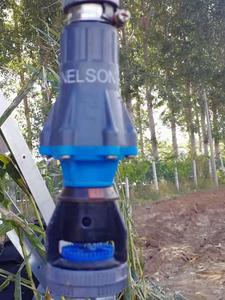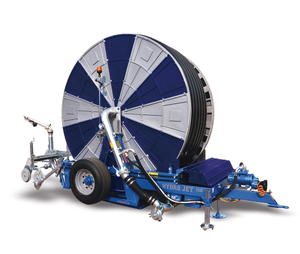(59814 products available)




























































































































































































































System irrigation for farms helps control water distribution, save water, and improve crop yield. There are various types of irrigation systems, such as surface, drip, sprinkler, and subsurface irrigation. Farmers can choose the best irrigation system for their crops and land.
Surface irrigation
This is the oldest form of irrigation. It's also known as flood irrigation. In this technique, water is allowed to flow over the field surface and soak into the soil. It can be controlled by shaping the land to direct water. It's suitable for crops like rice that require a lot of water. It's inexpensive and maintains soil moisture. However, it requires a lot of water and can cause soil erosion and waterlogging. It is best for flat land with soils that hold water well.
Drip irrigation
Also known as trickle irrigation, this system delivers water directly to the plant roots drop by drop through a network of tubes and emitters. It can be done above or below ground. It is suitable for various crops and reduces water wastage. It is efficient and reduces weed growth. However, it is expensive and requires electricity or a pump to operate. It is best for areas with little rainfall and sandy soils that dry out quickly.
Sprinkler irrigation
In this system, water is pumped through pipes and sprayed over crops like natural rain using overhead sprinklers. It is suitable for all types of soils and terrains. It uses water efficiently and reduces soil erosion. However, it can be expensive and may require more water than other systems. It is best for areas with moderate rainfall and can be used for all crops.
Subsurface irrigation
This system delivers water below the soil surface using buried drip lines or tubes. It is suitable for row crops, orchards, and vineyards. It reduces evaporation and waterlogging and can be used in sandy or clay soils. However, it is expensive to install and maintain and is not suitable for all crops. It is best for areas with little rainfall and sandy soils that dry out quickly.
A farm irrigation system's design is influenced by its size, the kind of crops grown, soil characteristics, water availability, and climate conditions. The main objective of this design is to offer adequate water supply while conserving water and maximizing efficiency.
Field layout and sizing:
The layout of a farm is considered when designing its irrigation system. This includes identifying the size and shape of fields, as well as the topography. Fields are divided into manageable units for furrow, basin, and drip systems. In sprinkler systems, main pipelines should run parallel to the longest side of the field, while the latter is divided into smaller units for lateral pipelines. The size of the irrigation system depends on the water source's capacity to supply water while considering the crop's critical growth periods.
Water source and management:
The design of irrigation systems relies heavily on water sources such as rivers, wells, reservoirs, or ponds. It evaluates the quality and quantity of water available and develops structures for storage, distribution, and management. Water conservation methods, like rainwater harvesting and recycling, are integrated into the design to ensure sustainability.
Soil and crop consideration:
The design considers soil types, infiltration rates, and drainage characteristics. It also looks at crops' water requirements throughout different growth stages. This information helps determine the amount of water that should be supplied, the irrigation method that should be used, and when it should be applied.
Irrigation components:
The components of farm irrigation systems include water sources, pumps, pipes, valves, filters, controllers, and distribution networks. Each component is designed to ensure the system's efficiency and longevity. For instance, pumps are selected based on their power to overcome elevation differences and deliver the required water volume. Pipes are designed with materials such as PVC or HDPE, which are resistant to corrosion and have a long service life. Valves control water flow and pressure within the system, while filters remove debris and sediments to prevent clogging of nozzles and emitters.
Farm irrigation systems are significant for farmers and their fields. Here are some crucial situations where these systems are very helpful and necessary:
Regular water supply:
Farm irrigation systems ensure that crops get enough water regularly, even in places where rain is infrequent or irregular. These systems make it possible to water the fields daily or weekly, depending on the needs of the plants. They are especially useful for growing crops that require a lot of water or in dry areas where rainfall is not reliable.
Conservation of water:
Irrigation systems help save water, which is vital in areas where water is scarce or where water conservation is necessary. Drip irrigation, for example, delivers water directly to the roots of the plants and reduces wastage. This becomes beneficial as it lowers water bills and helps in sustainable farming practices.
Improvement of crop yield and quality:
With an irrigation system, farmers can control how much water their crops receive. This controlled watering improves crop yield and quality. Plants that get the right amount of water grow healthier, produce more fruits and seeds, and have better taste and nutrition.
Support in drought management:
Irrigation systems are particularly useful during periods of drought or water scarcity. Even when there is no rain for a long time, these systems ensure that crops get the water they need to survive and thrive. This capability makes irrigation systems crucial for food security and farmers' livelihoods in dry seasons.
Flood prevention and drainage:
Some irrigation systems help prevent floods and manage excess water. They include drainage systems that remove extra water from the fields, preventing waterlogging and soil erosion. Such systems help maintain the right water level in the soil, which is good for plant growth.
Soil conservation and health maintenance:
Irrigation systems help in soil conservation. They lessen soil erosion, maintain soil structure, and prevent the salinization of soils. Healthy soil is crucial for farming since it provides the nutrients that plants need. Irrigation systems keep the soil in good condition, benefiting the crops.
Timing and flexibility:
Irrigation systems give farmers the flexibility and freedom to choose when to water their crops. With these systems, farmers can irrigate their fields anytime, even at night or during off-peak hours. This convenience allows them to schedule watering at times that will not disrupt other farming activities. Furthermore, farmers can adjust their irrigation schedules based on the changing needs of their crops.
Technology integration:
Modern irrigation systems can integrate with advanced technologies such as sensors, automation, and remote monitoring. These technologies enable farmers to monitor soil moisture levels, water usage, and irrigation performance in real-time. With automated irrigation systems, farmers can set watering schedules and adjust water flow using smartphones or computers. This tech integration improves irrigation efficiency, lowers water usage, and makes farming easier.
Farm irrigation systems vary in design and structure depending on several factors. Here are some important things to consider when choosing an irrigation system for farms:
Soil type and topography
The kind of soil on the farm and its topography should be considered when deciding what irrigation system to use. Some irrigation techniques work better with certain soil types than others because they consider how quickly water drains through different kinds of soils. For instance, drip irrigation systems are good for sandy soils since they drain water fast, while sprinkler systems can be employed on level lands where there is clay soil that holds water well.
Crops and water requirements
The crops grown on the farm and their need for water also determine the kind of irrigation system to be used. Different crops have varying water needs, some requiring more than others at different stages of growth. Knowing this helps in selecting an irrigation method that will provide enough water for all the crops being farmed. For example, high-value vegetable crops with large water demands may benefit from a drip irrigation system, while grains that require less water could be irrigated using a center pivot system.
Water source and quality
The source and quality of water available on the farm are important factors to consider too. Farmers should look at how much water they have access to and where it comes from, whether it is from rivers, wells, or ponds, and what its quality is like (e.g., salinity levels). This information is necessary for choosing an irrigation system that matches their water supply and its suitability for use.
Labor and management
The amount of work involved in managing different irrigation systems is also something that should be considered before making any decisions. Some methods require more manual labor and management than others, which may not be feasible for all farms depending on their circumstances. For example, sprinkler systems need regular checking and maintenance, while drip irrigation systems need less labor but require proper installation and monitoring.
Cost and budget
The overall cost of setting up an irrigation system and its budgetary implications must also be considered. Different types of farm irrigations have varying initial installation costs and ongoing operating expenses, which should be evaluated against one's available resources. It is important to do a cost-benefit analysis that takes into account both the short-term and long-term financial impacts so as to select the most affordable option in the long run.
Energy efficiency
Energy efficiency should be considered, especially for irrigation systems requiring pumps or other powered equipment. Using energy-efficient pumps and renewable energy sources such as solar-powered irrigation can reduce fuel costs and make irrigation systems more sustainable.
Flexibility and scalability
The flexibility and scalability of an irrigation system should also be considered. As farms grow or change their crop plans, they may need to expand or modify their irrigation systems. Drip irrigation can be easily added to or modified, while sprinkler systems require more planning for future expansion.
Q1. What are the benefits of a farm's automatic irrigation system?
A1. They save time and labor, ensure consistent watering, prevent over/under-watering, conserve water, enable targeted irrigation, allow for system monitoring, and provide flexibility.
Q2. Can a drip irrigation system work in various soil types?
A2. Yes, drip irrigation works well in sandy, clay, and loamy soils by adjusting the discharge rates and emitter spacing to meet the specific needs of different crops.
Q3. How can farmers save water and energy with irrigation systems?
A3. Farmers can save water and energy by adopting drip irrigation systems, utilizing rainwater harvesting techniques, and employing irrigation system technologies that optimize water and energy use.
Q4. What role does the water source play when choosing an irrigation system?
A4. The water source determines the availability and quality of water supplied for irrigation and influences the design, efficiency, and sustainability of the irrigation system.
Q5. How can irrigation systems increase crop yields?
A5. They provide timely and adequate water, reduce stress on plants, and create a favorable growing environment, ultimately leading to increased crop production and quality.